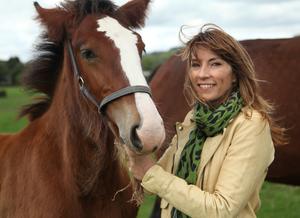 |
|
| photo: David Dunkerley | |
An Oxford-trained zoologist and documentary filmmaker, Lucy Cooke is no stranger to the animal world. In The Truth About Animals: Stoned Sloths, Lovelorn Hippos, and Other Tales from the Wild Side of Wildlife (Basic Books, April 2018), she takes us on a journey to the past to discover how ancient and medieval scientists and philosophers got so many facts about animals astonishingly--and often hilariously--wrong. She then takes us into the world of modern-day science to show how today's scientists are working to correct those old animal myths--while inadvertently creating new ones. It's a fascinating and immensely engaging book about the natural world and humanity's hubris and failure in our attempts to understand it.
You write in the introduction that to "understand animals, context is key." The context you offer in your book is fascinating, and often hilarious. Tell us about your research process--did you think it would take you as far back in time as ancient Greece?
As a presenter and producer of natural history documentaries I am very lucky to have joined some of the world's best biologists in the field chasing sloths (harder than you might think) and a host of other critters. It was listening to these experts who highlighted how much we misunderstand so many animals today. I had a hunch that going back to the sources of this misinformation might be a rich vein for storytelling but I had no idea quite how far back it would take me or quite how fascinating it would prove to be.
What surprised you the most while researching this book?
I was very surprised by how old some of our prejudices about certain animals are. Take the hyena--reviled today by many as a mistrustful coward. This misconception dates all the way back to the bestiaries written in the middle ages. These were the first animal encyclopaedias, and they mixed folklore and morality tales with only a sprinkling of fact, yet many of their prejudices are still alive and kicking in the 21st century.
As much as I loved learning about the animals, I also enjoyed learning that you love sloths--you even founded the Sloth Appreciation Society. What is it about these slow, "lazy" creatures that makes you love them so?
They are one of the planet's most misunderstood creatures. We have a habit of viewing the animal kingdom through the prism of our own existence. As busy bipedal apes, we are obsessed with moving faster than nature intended--busyness is a badge of honour and sloth a sin. But sloths are one of the tropical jungle's most successful mammals, and the secret to their success is their slow, stealthy, sustainable nature. Instead of derision, we should look to the sloth as an energy-saving icon of the 21st century, and try to be less cheetah and more sloth ourselves.
One of the funniest--and frankly, grossest--moments in your book is when you admit to trying beaver castoreum, a secretion from a beaver gland, on yourself to cure a fever. I must know: How did you feel in the immediate aftermath, and how do you feel now?
Nibbling on beaver "glands" (an ancient panacea) to test whether they could cure my own "hysteria" was indeed one of the grossest things I had to do for the book. They had a distinctly bitter taste that I am struggling to forget. And they failed to remove my fever despite containing salicylic acid--a natural component of aspirin. An expert in the matter told me I would have to consume a terrifying amount in order to have any effect--something I would not recommend.
Your chapter on bats discusses how humans during World War II thought that bats might be useful for carrying bombs. That's a fascinating tale, but what really struck me was the much more pedestrian fact that only .05% of bats carry rabies. Why are bats, of all animals, so deeply feared by so many people?
There are a number of reasons why people fear bats. They are otherworldly creatures that inhabit the night and have the spooky ability to navigate in the dark, which made them seem to have supernatural powers. Their appearance is also unnerving--they have a human-like face with forward-facing eyes and a body shaped a bit like ours, but they have big leathery wings attached to their massively outsized hands. So, they are human but inhuman at the same time.
In your conclusion, you write that "with the rise of efforts to discredit science, there has never been a greater need for truth." What do you see as being some of the greatest threats to science--animal science or otherwise--in our current moment?
The fact that evolution is still considered a "theory" and is not taught in many U.S. schools despite plenty of rock-solid evidence is a pretty worrying state of affairs in 2018.
You write that anthropomorphism is "enemy number one" to animals. Why does our tendency to humanize animals present such a danger to them?
We are in the throes of a massive extinction crisis caused by human behavior. The natural world is in a state of emergency. In order to protect animals we have to understand them. Anthropomorphising animals makes us think they are like us, when they are not. Because of their cute anthropomorphic faces and antics we think pandas, for example, are sex-shy evolutionary mishaps that need our help to exist--the only way to save them is for us to take charge and breed them in captivity. The reverse is true--we just need to leave them alone and stop destroying their habitat. --Amy Brady

